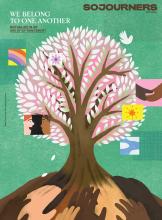AFTER THE SOLEMN journey of Lent, through which we embrace the mystery of the death of Jesus Christ, we enter the mystery of Easter, a new life. And as we celebrate Easter, we cannot remain in the feelings of fear and anxiety, which merely lead us into inaction. All the gospels’ Easter narratives include the empty tomb. Our standing in front of the empty tomb symbolizes our standing at the threshold to new life. For example, in John’s gospel we imaginatively encounter Mary Magdalene, who runs to the grave with spices to prepare for Jesus’ funeral while continuing to be sad. However, at the dawn of Easter she hears Jesus say, “Do not hold onto me.”
At the very familiar space of death, representing deep feelings of despair, Jesus’ voice introduces a cut or prohibition and indicates that the old way cannot continue to operate beyond this point. Upon hearing this, Mary must face the empty tomb, which signifies a lack or a hole. The starting point, then, from which to walk into the paschal mystery, can be the acknowledgment that the lack of full wisdom, perfection, and completeness is the reality of the self and the world. Often, we experience resistance to moving or walking onto a new or unknown path, while still fully knowing a new life is waiting. The life of resurrection commands us to step into the resurrected body of Jesus Christ. In this pandemic-ridden time, what does it mean to walk into the new life of the Risen Christ?
Read the Full Article

